Types of worms in potted plants can be worrying, especially if you find yourself to be one of those people who are exceedingly fond of their homegrown plants.
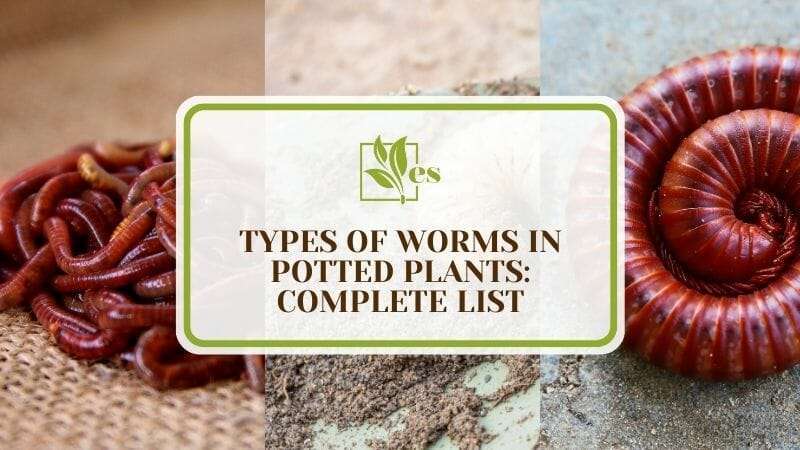
So naturally, as soon as you realize what’s happening, you start panicking about the plants that were your comfort and calm.
But know that not all worms are harmful; some help the plant grow better, read this article, to find out all about these worms.
JUMP TO TOPIC
Types of Worms in Potted Plants
1. Potworms
You likely have a pot worm infestation if you’ve noticed little white worms in your plants. A pot worm has tiny, white worms that invade in great numbers. White worms are helpful worms that can promote the health of plants.
They create tunnels in the soil, allowing air and water to pass through easily, while removing excess food sources for harmful bacteria. The best part is that these worms don’t tend to damage potted plant roots.
Although they are little, but these white pests spread rapidly, and you may be able to find more than 2500 pot worms or Enchytraeids in a square foot of container ground. However, this population does not negatively impact the soil’s broad ecosystem due to the vast number of pot worms.
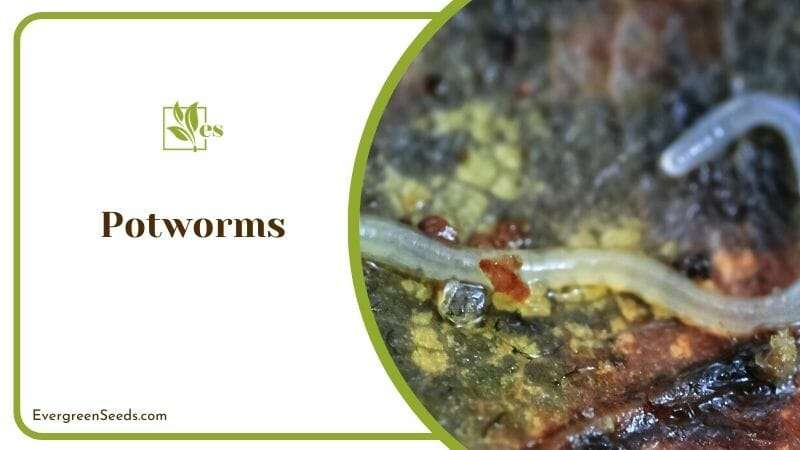
These worms are soil-dwelling creatures that eat decomposing materials. They are advantageous for plants because they assist in forming tunnels that permit easy air and water passage while removing additional food sources for harmful bacteria.
In addition, they enjoy a somewhat acidic atmosphere. As a result, they will start to grow as soon as you add acidic material to the container soil.
The advantages of pot worms are similar to those of earthworms. In plants regarding their effects on plants and soil. However, they seldom ever have an impact on living plants, because the worms make tunnels in the soil that make it easy for air and water to move through, they will aid in the growth of potted plants. On the other hand, they eliminate additional food sources for dangerous germs and don’t usually hurt the roots of houseplants in pots.
Pot worms do not directly affect plants that are unfavorable for plant health, as was previously stated. Their propensity to multiply, though, might eventually cause problems. Other worms will compete for food if the population exceeds the capacity of the food supply, but they won’t.
2. Red Wigglers
Red wigglers are most likely what you’re seeing if you find little red worms in plants. The average population of this worm, which is one and a half inches long and quite delicate, is roughly 100 per square foot of potting soil. Therefore, all around the U.K. and North America, plants cultivated outdoors or indoors with new potting soil are susceptible to this type of worm.
Due to their preference for living in organic stuff like compost piles or extremely fertile garden soils, Red Wigglers are also referred to as manure worms potted plants, and scientifically they are called Eisenia Foetida. They are essential to any ecosystem containing potted plants since they feed on decomposing plant matter.
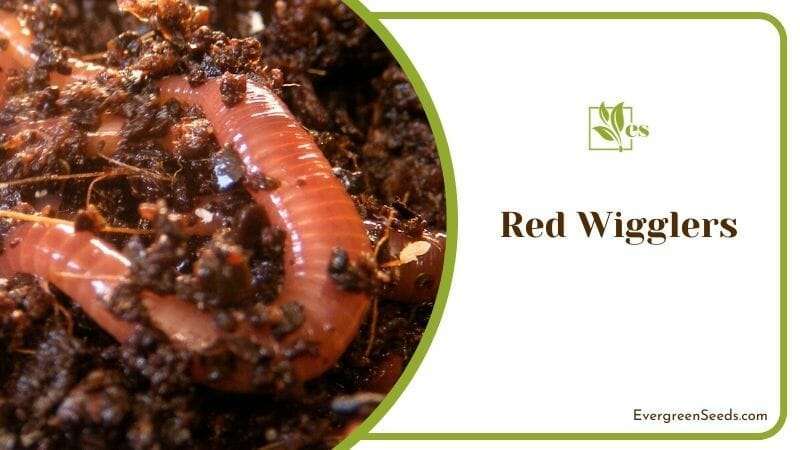
Like other earthworms, the Eisenia Foetida like sifting through the soil in search of moist, warm environments. Red worms’ proclivity for inhabiting warm environments, including They tend to dig up the ground, as is the case with most earthworm species in pursuit of moist, warm climates.
Usually two to three inches long, red wiggler worms, are supposed to appear physically red, as their name suggests. However, you can see tiny yellowish imperfections at the end of their bodies, their tails, which would look like bruising.
Red wigglers have a segmented body structure, just like all other earthworms seen in gardens and flower pots.
They prefer to reside in plants because they have constant access to decomposing organic waste. Although they don’t need much moisture to survive, which means that you can discover them digging deep within the soil of plants in search of food and water.
3. Grub Worms
June bugs, commonly referred to as grub worms, are the larvae of beetles in the Scarabaeidae family, and scientifically they are called Phyllophaga. Because they feed on plant roots, these pests can severely threaten gardeners and potted plants.
On the other hand, adult beetles would lay their eggs in the soil, and the effecting larvae hatch and start eating plant roots. As a result, grub worms can cause significant harm to gardens or plants in pots.
Grub worms have a brown head capsule and a cream body color. They are soft, and you can easily crush them between your fingers. When fully grown, they can reach an inch in length.
A few quick ways to identify a Grub worm is that it will come as a white, bloated body. The size is tiny, perhaps less than an inch long, in the shape of a “C.” It has six legs and a grayish bottom piece that makes up the upper portion.
Typically, their natural habitat would be found in soil, grub worms eat the roots of plants. They likely originated from your garden or lawn if you discover grub worms in your potted plants. In search of food, grub worms are incredibly mobile and can quickly move from one location to another.
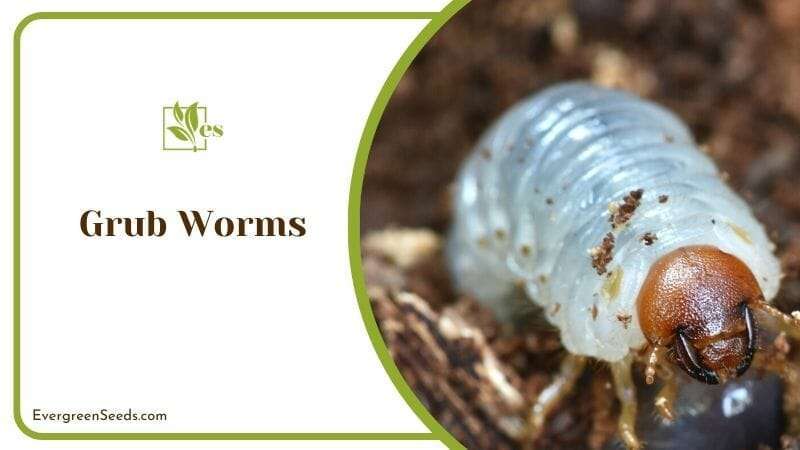
Months pass during this worm’s life cycle phase, which encompasses both the winter and the summer. The springtime is when they mature into adult beetles.
One of the most harmful parasites for plants is this worm, which provides little benefit to hosts and are harmless black worms in plant soil. So if you are wondering, are worms bad for plants? Grubworms cross that list.
These unattractive natural predators also endanger your plants when they live in the pot. The main risks they present to plants are how they would plants. On the other hand, if they enter high numbers, they can obliterate entire communities of plants.
These worms would travel in search of food, which is the most significant problem since they can spread illnesses like verticillium wilt that would easily harm potted plants. Grub worms typically require you to completely replace the dirt in the container and re-pot the plant.
4. Millipedes
Small, segmented worms, known as millipedes, have two pairs of legs on each portion of their bodies. They do appear similar to centipedes; however, their name refers to their worm-like bodies with several segments. Infestations of millipedes in potted plants generally happen in wet weather or when potted plants are moist for an extended period.
Most millipede species are considered harmless to plants because of their “Neutral” nature. Nevertheless, their moist resemblance is preferable under a container plant rather than in dry and cool outdoors.
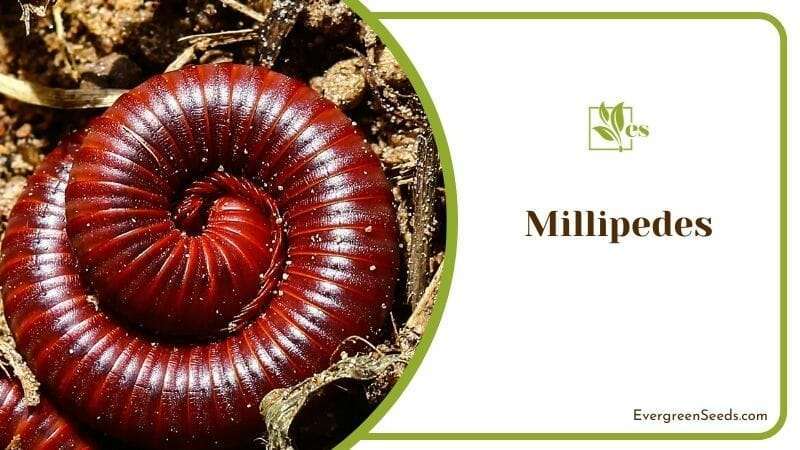
Since they have a distinctive appearance, millipedes are simple to recognize in plant soil. They are segmented, long, and thin worms. Because each segment includes two legs, they are known as “millipedes.” Typically, millipedes in potted plants are between half an inch and six inches long.
In their habitats of moisture and vegetation, millipedes eat plant matter. Therefore, they can be discovered in moist areas such as compost piles, garden plants, and mulch, as they would do so in order to hide from predators, hence they prefer damp, dark habitats, which is why the pot of your plant is the best for them.
5. Nematodes
These worms are incredibly tiny, usually measuring between one-sixteenth of an inch and two millimeters. They resemble small snakes, despite having a simple worm shape and without legs or antennae.
Without magnification, nematodes can be challenging to spot; thus, to correctly identify them, you might require the assistance of someone with nematode identification training.
Nematodes are creatures that dwell underground in the plant soil and eat plant roots. Their feeding results in yellowing plants, little flower or fruit output, wilted leaves, poor growth rates, and decreased yields for plants.
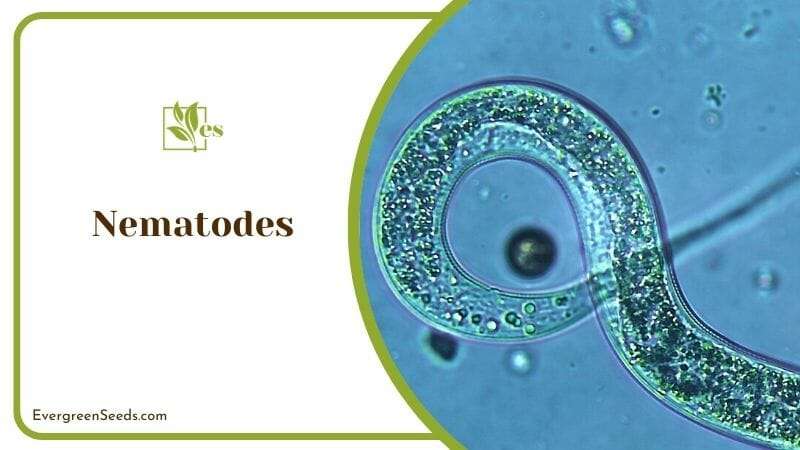
Most of their lives are spent in the soil of plants, where they wait for a root system to approach before latching on to it like leeches sucking blood. Overall, these worms come in five different species, each with unique traits, as their food preferences are one of the criteria used to classify each species.
You might need to take some actions to eliminate the nematodes if they have infested your potted plant. For example, you might try using a nematicide that is sold commercially, or you could dig out the top layer of soil and add fresh potting soil. After treatment, thoroughly water the plant to help the new earth cling to the roots.
These tiny worms, including the well-known red wiggler, are considerably distinct from the other worms on this list. This species comes in a few different forms, including infections that affect people, animals, and plants.
6. Earthworms
Adding earthworms to your plants is a good idea. As was already said, your plants benefit from having the correct number of earthworms, they won’t be harming the plants.
Aerating the soil for the roots of your plants, providing nutrient castings, and other advantages of earthworms are just a few. In addition, it would help if you incorporated earthworms into your plants because they improve the drainage of waterlogged soil, especially if you’re trying to find a low-cost source of fertilizers for your plants.
In addition, if your plant shows signs of oxygen deficiency in its roots, earthworms can help here too. The benefits of having earthworms in your potted plants are too good to pass up on.
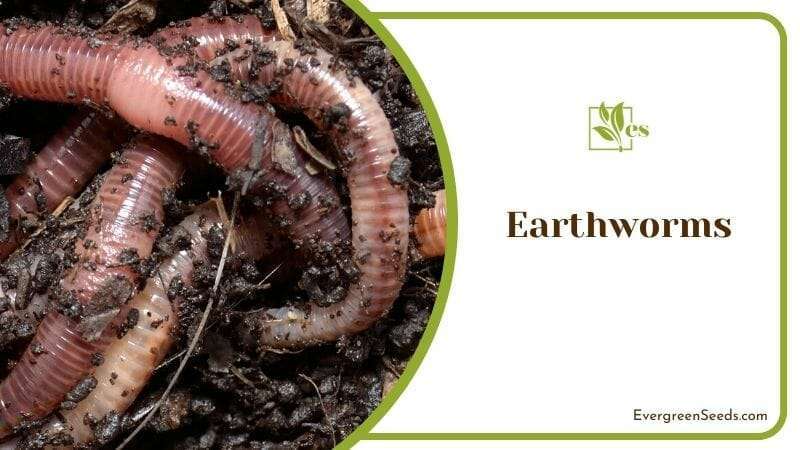
Du to their ability to aerate the soil and convert organic materials, like leaves, into essential nutrients for plants to grow, earthworms are useful for plants.
As you add them to potted plants, it would easily encourage your plant’s development and nurture. These worms in your plants’ soil are a frequent issue that can be challenging to spot and even more challenging to eradicate.
In plants, there are many distinct kinds of worms, and they all behave differently. When you see tiny brown worms in plant soil, you will generally dislike them because they are unattractive and annoying.
However, they can be suitable for plants! Earthworms are very much like these. Because of their distinct brown color, they are truly beneficial for your potted plants and the soil they live in.
7. Cutworms and Caterpillars
Cutworms, which are moth larvae, can harm gardens and houseplants. They aren’t typically found in the soil like most pests described. Instead, you can observe them on the stems and leaves of plants. Because all caterpillars devour plants, they might obliterate an entire garden if they molt and reproduce.
Vegetable plants, especially carrot and tomato plants, are highly appealing to cutworms, and you will find them in the pots. They have different patterns like spots and stripes and come in black, pink, white, and green colors. Cutworms breed in significant quantities, so if you find one, you will undoubtedly find many.
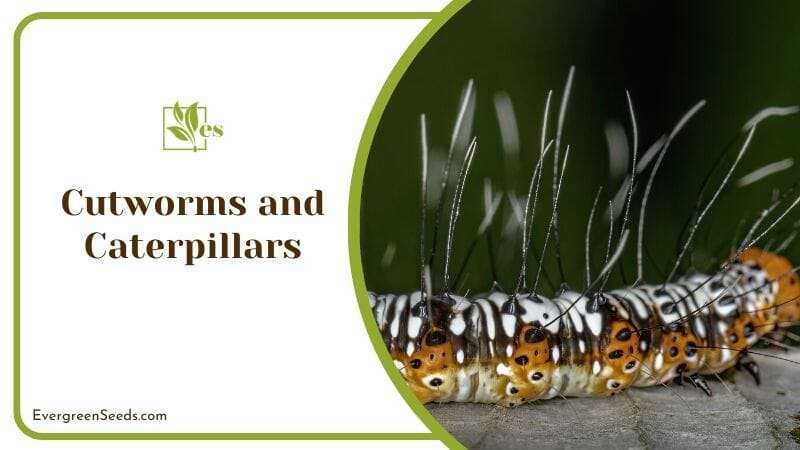
Making a solution of dish soap and water and spraying it on the plants is the most effective technique to eliminate cutworms and caterpillars. Since cutworm activity is at its peak at night, you should spray them then.
However, to make sure that they perish, you might need to repeat this several times, and to be able to destroy them, you can also remove them from your plants and submerge them in hot, soapy water.
If the cutworms don’t perish, you may always buy a pesticide made specifically for cutworms and caterpillars, like pyrethrin, to sprinkle on your plants.
8. Aphids
The underside of leaves is where aphids prefer to remain. So regularly look under the leaves for them. Aphids like to consume plants, but they also secrete a substance that coats the leaves of the plants with a residue. This residue keeps the plant from receiving enough sunlight, which inhibits photosynthesis.
Spraying a mixture of insecticidal soap and water on your plant will effectively eliminate aphids and their eggs. You can also clean the large leaves of plants with a plant-safe towel wet with warm, soapy water.

However, the white flies and spider mites will also be killed and prevented by this remedy. Some homeowners also use neem oil mixed in warm water to prevent them from spreading, in addition, note that Coffee grounds can also be spread to control this infestation.
Keep in mind that aphids would be feeding on a houseplant by sucking the sap out of the leaves, buds, and flowers, similar to most indoor plant pests. Nonetheless, it can result in stunted growth, distorted leaves and flowers, yellow leaves, and leaf and bud drop since they like to cluster and feed on a plant’s new development and flower buds.
Fortunately, aphid damage to a houseplant is typically not severe. A large houseplant would take a long time to be killed by aphids, even though they will do it eventually.
9. Seed Gall Nematodes
Unsegmented roundworms called nematodes frequently inhabit soil and attack plants. Because they destroy grubs, maggots, and other nematodes, certain nematodes are beneficial and can help the plants.
On the other hand, plant-parasitic root knot nematodes attack plants and devour the root system using needle-like styles. Nematode infection signs, such as yellow leaves, wilting, and stunted development, are similar to those of drought.
Garden beds are more commonly affected by plant-parasitic nematodes than indoor plants, but it is still simple to bring them inside on your clothing or if you use garden soil as potting soil. Nematode infestation can be treated chemically, but a natural approach works better and exposes you to less toxins.
If you wish to get rid of nematodes, it is possible and many gardeners do it. Here is a way that you can get rid of nematodes from your potted plants: Pull the plant out of the pot while holding it over a trash pail.
Throw out all of the potting soil right away, as by doing this over a trash can, you reduce the chance that the nematodes may spread to other plants or throughout your house.
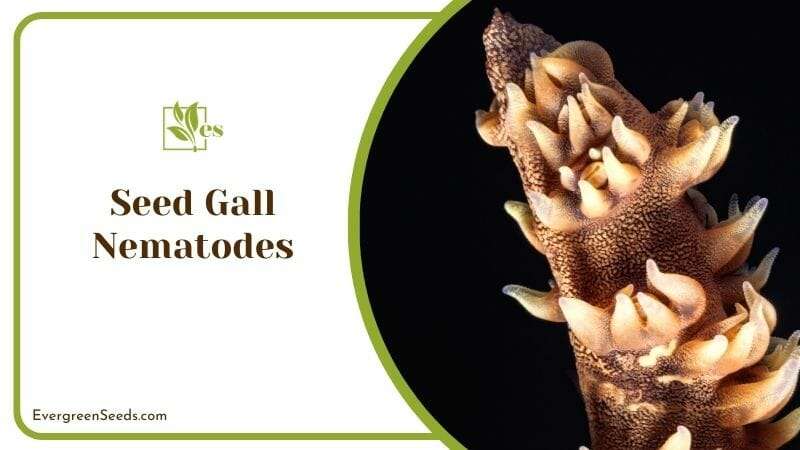
Then, you need to remove any loose dirt by shaking it off the plant roots. Nematodes that you see stuck and glued to the roots can be removed and thrown away right away. Tweezers can be your best friend here.
While you get the pot ready for repotting, temporarily place the plant outside in the sun. Nematodes that have been left on the roots can be dried up and killed by even brief sun exposure.
To get rid of any germs, wash the potting container and sterilize it in a 10 percent bleach solution. Then, replant the houseplant at the original planting depth after adding the fresh potting soil to the container.
Remove the potting mix from the top one to two inches of the container. The potting soil’s organic substances are home to helpful fungal cultures that, like a spider web, catch any surviving nematodes before slowly absorbing and killing them.
With organic mulching material, such shredded bark or straw, completely fill the container. The mulch adds more organic material to feed the helpful fungus while also preserving moisture in the soil.
Finally, To eliminate any nematodes that may be present and to create beneficial fungus to fight nematodes if they become a problem in the future, add organic compost and mulch to the remainder of your houseplants. If a new infestation appears, replace the existing organic material in the potting mix. Check out some more ways to get rid of all the worms in your potted plants.












